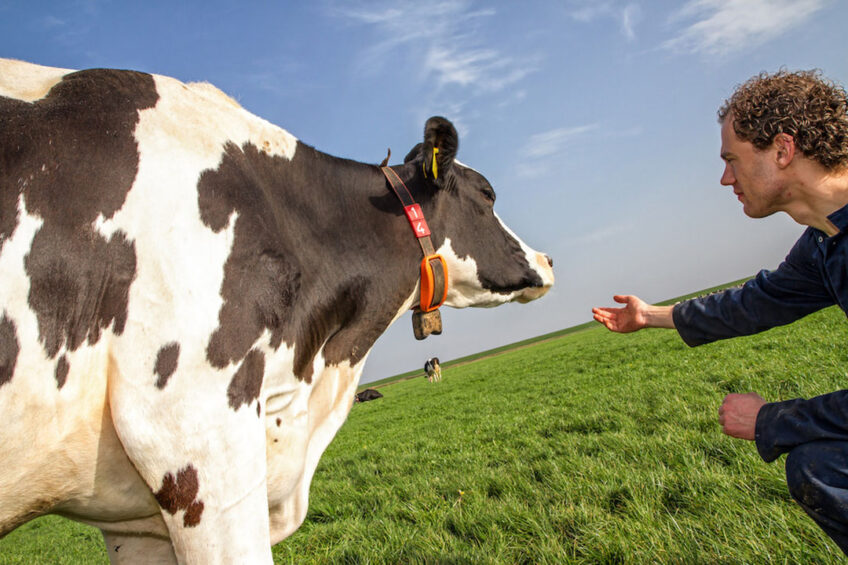AI technology reduces antibiotic treatment in dairy cows

Detecting the early signs of sickness as well as quick recovery of cows is key for animal health, welfare and a reduction of antibiotics. A study has shown that with Ida, an intelligent dairy assistant, the recovery time of cows can be reduced by more than half.
Ida, developed by agtech company Connecterra, uses a sensor, cloud computing, integration of data sources and artificial intelligence for early detection of cow diseases such as ketosis, mastitis or digestive problems. The prevention of cows becoming clinically ill will reduce the number of days the cows needs to be treated with veterinary medicine, such as antibiotics. Ida is a second pair of eyes on the farm, spotting early signs of anomalies in cow behaviour, which are often the first signs of sickness.

2 years of valuable health data
To test the value of Ida as a true digital assistant and detector of sick cows on farms, Connecterra has been running a scientific field trial since January 2018 on two commercial dairy farms (Belgium and the Netherlands), each having a herd size of 100 milking cows. In the trial, randomly half of the cows received an Ida sensor. The field trial was done within the context of the Horizon2020 Internet for Food and Farm project and supported by Wageningen UR in the Netherlands. “It is the first time that we do such a field trial to test the use of sensor technology on the use of treatment days. Recently released data over 2019 gives us the information on the treatment days per cow over a longer period of time (25 months). The results are impressive and confirm what we have seen in the first year (2018) of the trial,” explains Niels Rutten, researcher at Connecterra and coordinator of the trial.

Fewer treatment days
From the beginning of the trial (month 1: January 2018) it is clear that the number of treatment days (= all treatment with antibiotics) is fewer for the cows with Ida, compared to the cows not equipped with the Ida sensors. The average treatment days for both farms for the whole period (Jan 2018 to Dec 2019) is 3.16 treatment days for non-Ida cows and less than 1 treatment day for an Ida cow. This means a reduction of -2.16 treatment days (-68%), hence resulting in less antibiotics. The difference between the Ida and non-Ida group was even bigger in 2019, compared to 2018. In 2019, the average number of treatment days for Ida cows was 0.71 days, compared to 3,16 days for the non-Ida groups. This is a difference of 2.45 treatment days (-77.5%).
Catching mastitis earlier
“These are great results and it shows that farmers use technology such as Ida to intervene much sooner. When Ida notices a reduction in rumination time for example, a farmer can act on it. A farmer may not always spot that a cow is eating less or lying more, but these behavioural changes are often the onset of disease. Having Ida means the farmer can check on the cow and prevent the disease from getting worse or clinical, hence leading to an overall drop in treatment days per cow. We see good results in the early detection of E. coli mastitis for example,” explains Rutten.
Kees Lokhorst, senior researcher smart farming at Wageningen UR in the Netherlands adds: “This experiment shows in practice that the Ida system is able to learn during time and is improving itself. The Internet of Things connected sensors and the central used Artificial Intelligence technology to improve warnings really supported the individual farmers in detection and treatment.”
Andy van Rossem is dairy farmer in Belgium and participated in the field trial. He clearly sees the benefits of the Ida health insights. “Knowing the early signs of sickness is one of the biggest wins of using this technology. Mastitis is one of the diseases that Ida detected at a very early stage. I get notified in the app when there is a little drop in ruminating and eating behaviour of my cows. I can then check on them and start (preventive) treatment sooner. For a costly disease such as mastitis it makes all the difference to be 1-2 days earlier with the start of treatment,” Van Rossem explains.
| Healthy cows for a healthy farm In the management of complex dairy farms, welfare of the cows and production costs play an important role. Keeping cows healthy can save a farmer a lot per year and reduce losses. This is especially the case for costly diseases such as mastitis, lameness or pneumonia. Wageningen University in the Netherlands calculated that mastitis costs a farmer €240 per lactating cow per year. In addition, this disease can result in a loss of 336 kilogrammes of milk. Canadian research showed that lame cows produce around 1.7 kilogrammes less milk per day. Keeping cows healthy helps maintain a resilient farm. Healthy cows reduce veterinary costs or losses when a cow dies or have to be replaced. |
The field trial, part of IoF, will run until the end of 2020. Together with Wageningen UR, Connecterra presented the first part of this study at the ECPLF in 2019.
For more info: Connecterra
Join 13,000+ subscribers
Subscribe to our newsletter to stay updated about all the need-to-know content in the dairy sector, two times a week.










